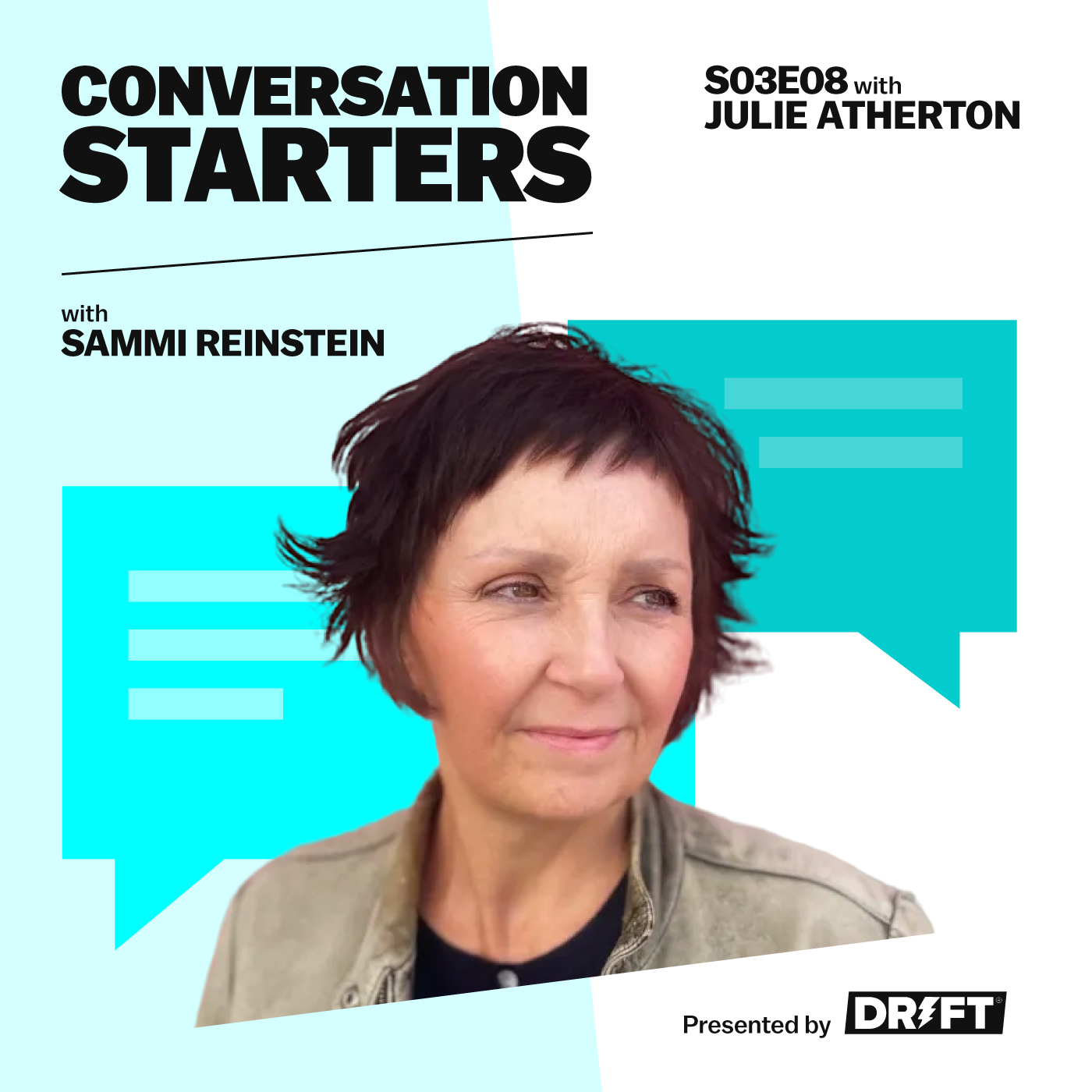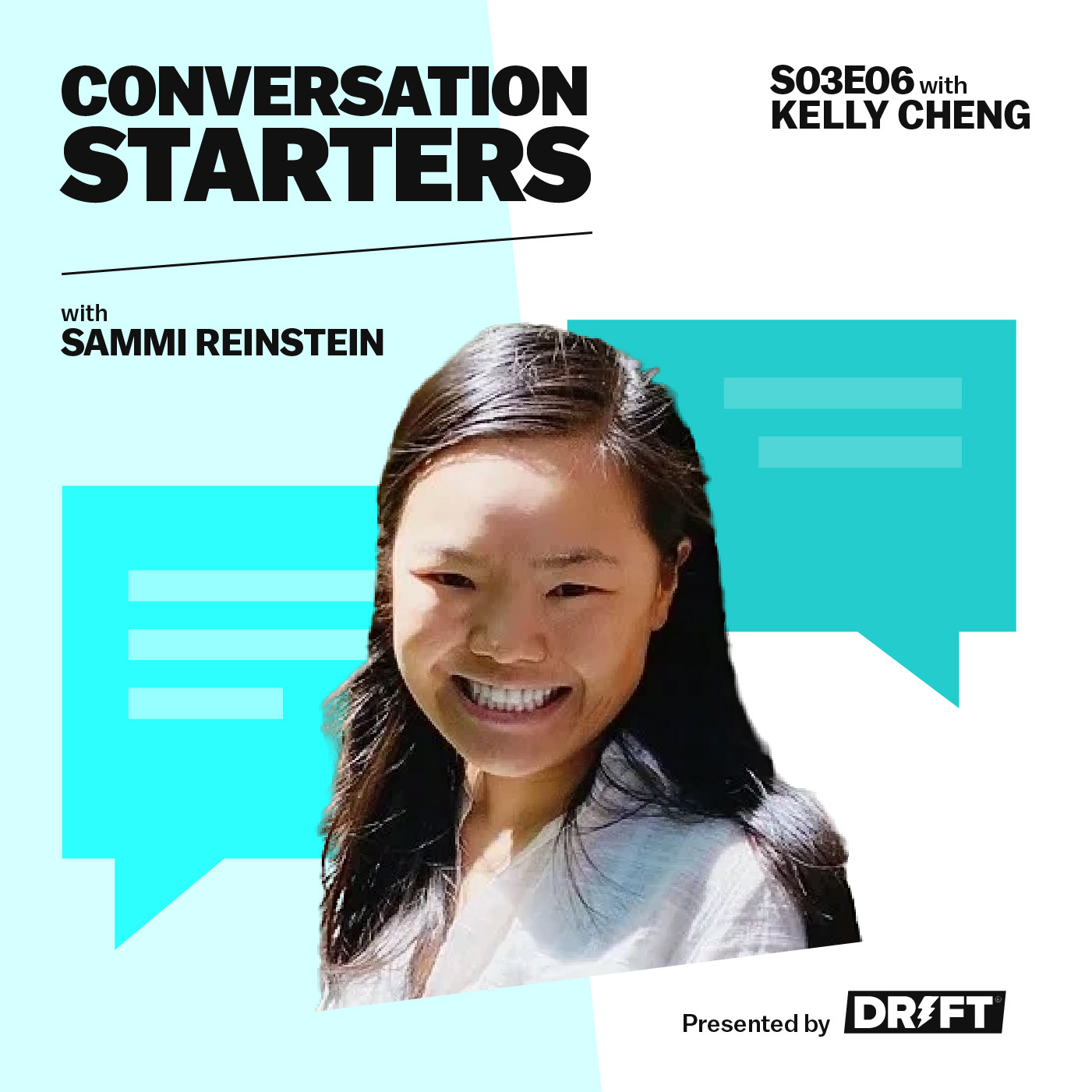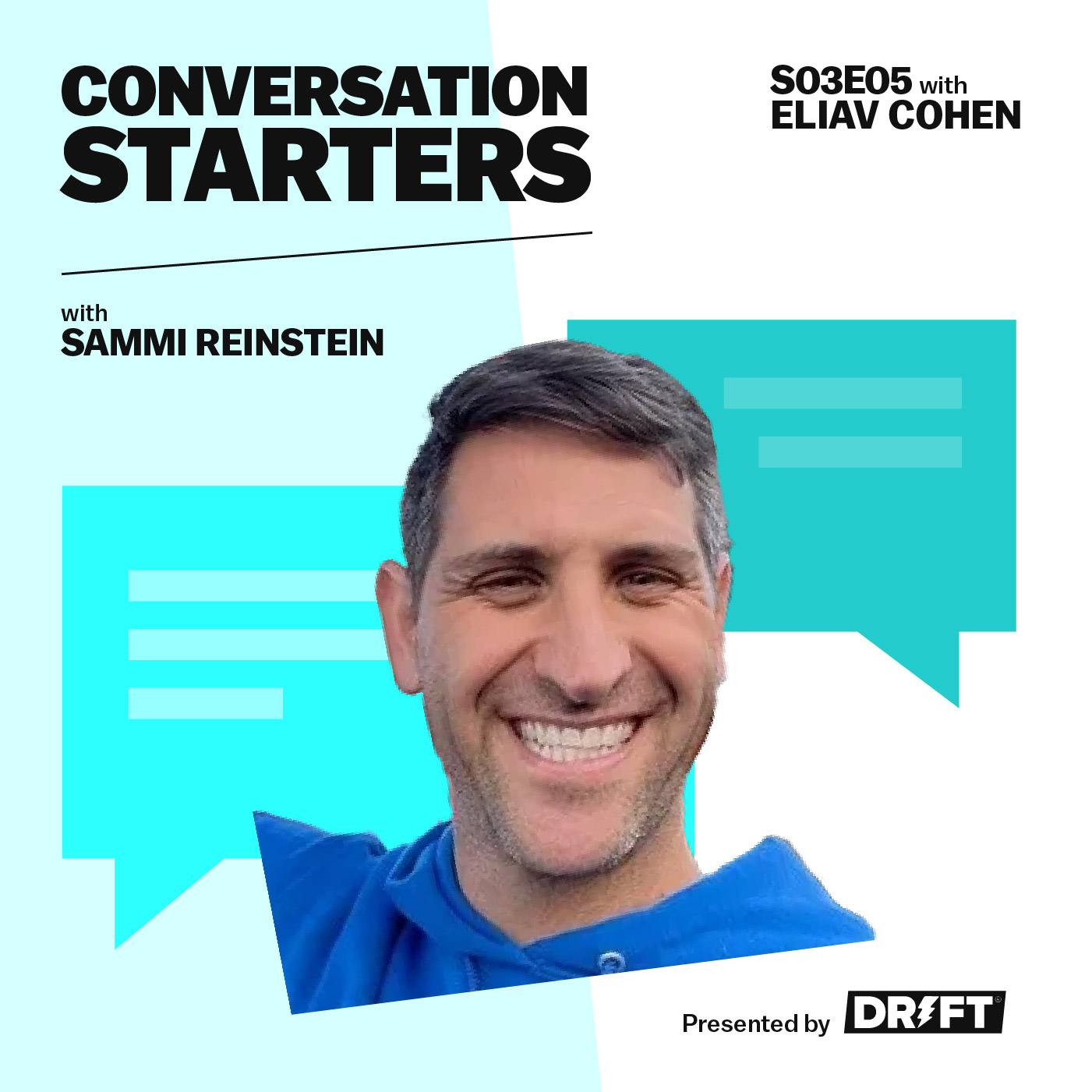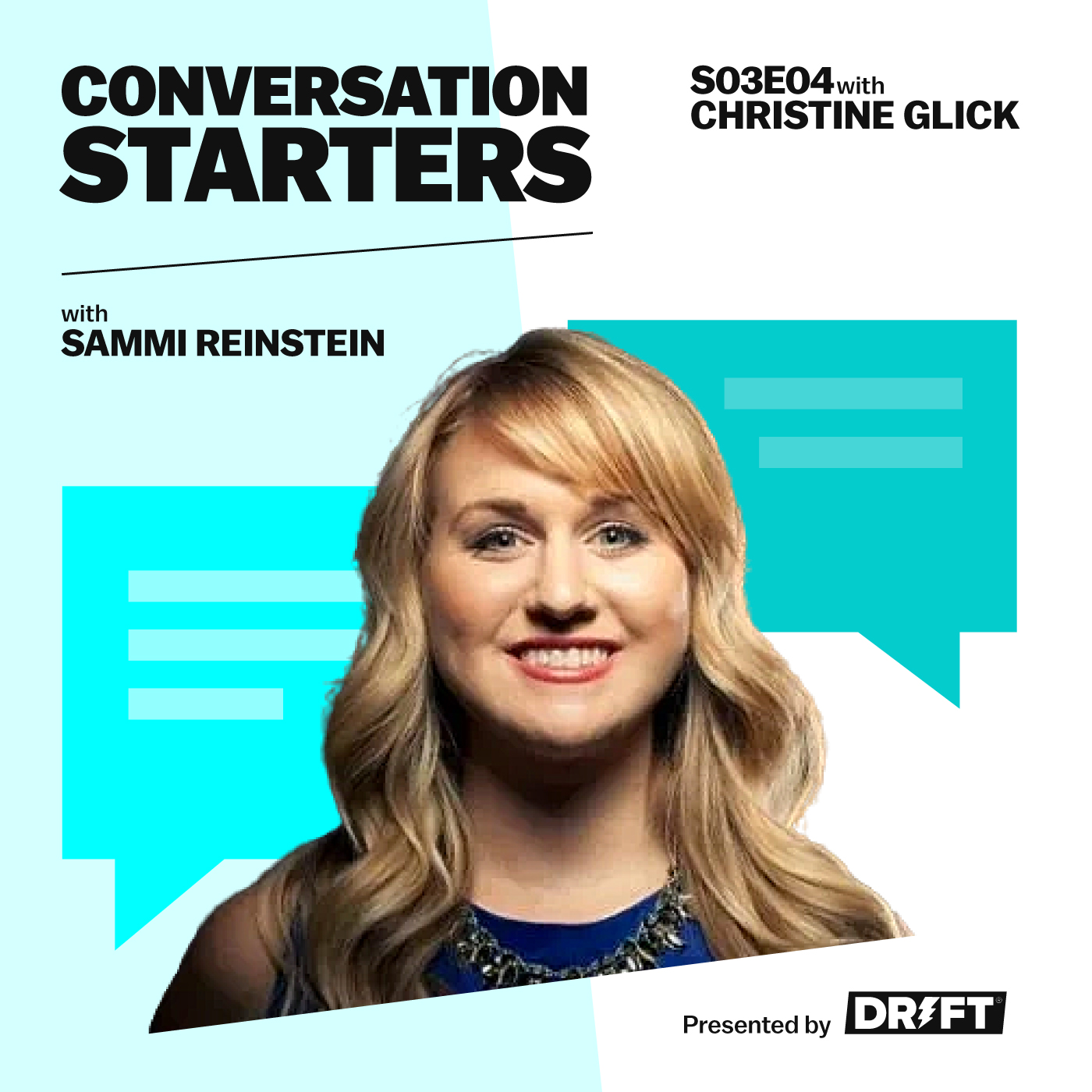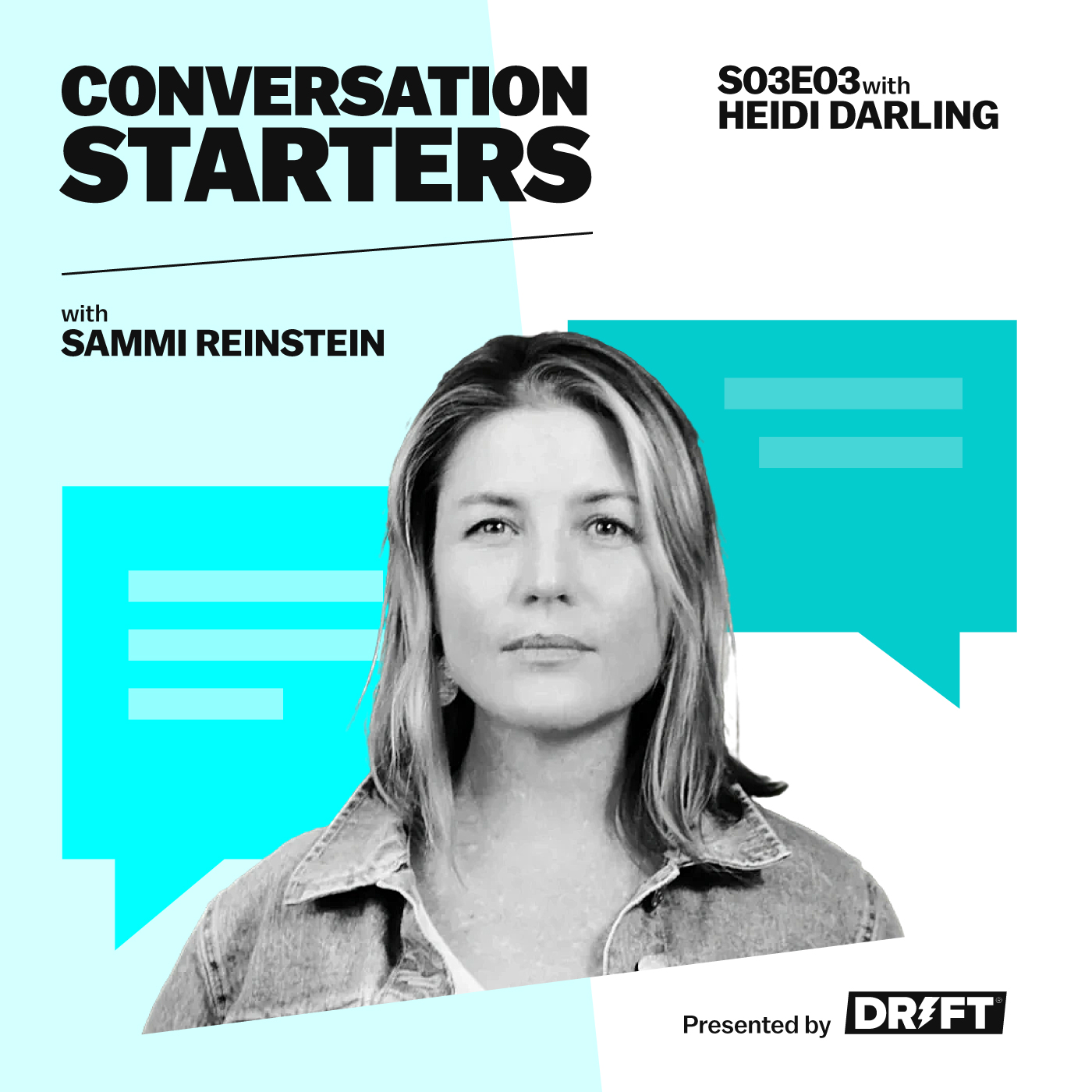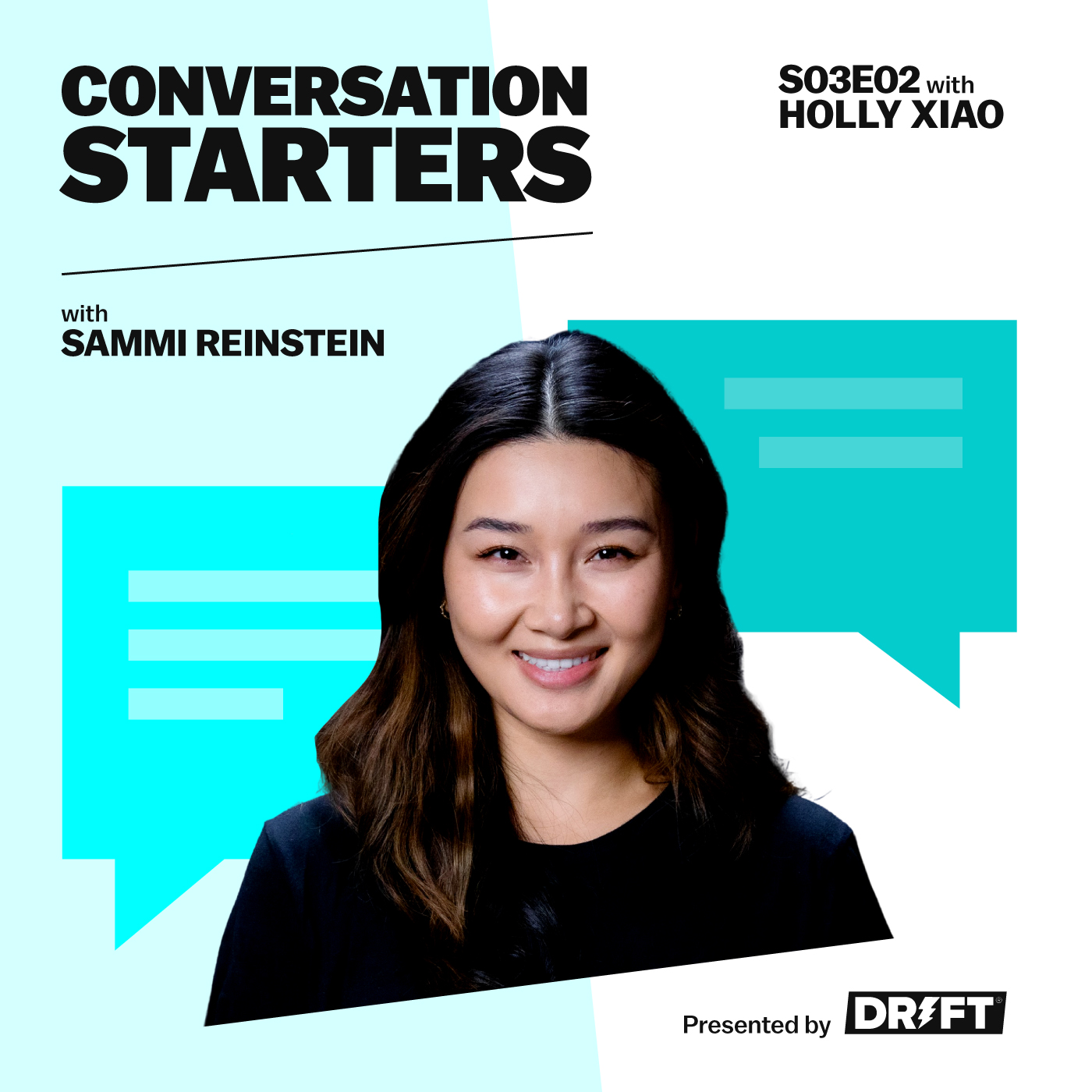3.8: How to Effectively Incorporate Social Media into a B2B Sales Strategy (Julie Atherton)
- 0.5
- 1
- 1.25
- 1.5
- 1.75
- 2
Sammi Reinstein: Hey, this is Sammi Reinstein, and you're listening to Conversation Starters. On this show, we talk all about bringing conversations back to B2B marketing and selling, because if there's one thing we know about doing business in the revenue era, it's that the best customer experience wins.
Speaker 3: Season three of Conversation Starters is brought to you by Really Good Sales Plays, a landing page built to inspire your sales team, whether they're inbounding, outbounding, or managing a deal. These plays are proven to generate pipeline and close deals so you can celebrate more wins. Check them out at drift. ly/ salesplays. Now to the episode. Sammy, if you could only use one social media platform for the rest of your life, what would it be?
Sammi Reinstein: The rest of my life?
Speaker 3: Yes.
Sammi Reinstein: That's a really hard one. Well, if it was for the rest of my life, I would say Instagram, because that's where most of my friends are, so I could keep up to date on their lives, but entertainment value wise, I've been big into TikTok.
Speaker 3: Okay, okay. That's fair. I'm a little biased, since I run a lot, but I think I'd have to say Strava, which would... To your point, the issue is a lot of my friends don't run, but the ones that do are on Strava, and I love the engagement on there, but I also think there's a difference between, like you were saying, going on Instagram versus TikTok and how much you actually post on it versus just scroll.
Sammi Reinstein: Yeah, the doom scroll.
Speaker 3: Yes.
Sammi Reinstein: It's gotten all of us here and there.
Speaker 3: Either way, definitely no question that social media's clearly playing a huge role in our lives if it was that hard to pick just one that you can live without, which is why today we are focusing the episode on social media's role in digital selling and the B2B buying experience. Today's guest, I'm not going to tell you who it is, you're going to have to wait for Sammy for that, but she is a social media subject matter expert that was connected to us through the Digital Marketing Institute. So thank you very much, DMI. This person has done a lot of work with the Digital Marketing Institute, including writing their ebook, How to Handle a Social Media Crisis, and serving as the instructor to their social media specialism social selling course, and their soon to be released 2023 digital strategies specialism. If you're interested in learning any more about any of those courses, click the links in the show notes.
Sammi Reinstein: Today, I'm excited to introduce Julie Atherton to the show. Julie is the founder of Small Wonder, a social media transformation advisory and marketing consultancy in which she spends most of her day advising and training both B2B and B2C organizations on how they can integrate a social media strategy into their broader strategic development and sales growth plans. Julie also published her second book, very impressive, B2B Social Selling Strategy. In the book, Julie shares a clear strategic framework for leveraging social media effectively as a brand. We're going to highlight a few specific aspects of the book today, but if you're interested in learning more about B2B social selling, we encourage you to read Julie's full book. Use the code AMKT20 for 20% off at the link in the show notes. So let's get into it. Julie, thank you so much for coming on the podcast and being our season finale guest.
Julie Atherton: Wow, thank you. Yeah, I'm very excited to be here. So really looking forward to it. Thanks.
Sammi Reinstein: So all throughout season three of Conversation Starters, before we dive into the hard hitting questions, we have been asking a conversation starter. Today's conversation is all about social selling, so I have to ask you before we begin, what is your favorite social platform for personal use, outside of business?
Julie Atherton: So my favorite social platform is actually Twitter, because I am a complete utter news junkie. So yeah, it's kind of the first one I look at every day, and through the day, I have all the little popups coming up, and so yeah, I'm constantly on Twitter, really. I don't post a lot on Twitter, but I follow various people and I'm pretty obsessive with it.
Sammi Reinstein: Yeah, I'm the same way. I'm not a huge poster on Twitter, but I love scrolling through, and I definitely follow a lot of people, get my news there, all of that, but TikTok did sneak up on me during the pandemic. I was definitely one of those people that was scrolling through TikTok and getting very distracted.
Julie Atherton: Yeah, it's interesting with TikTok, as well, isn't it, because it's become a lot... Facebook has a really big news channel as well, so a lot of people are getting their news there as well, but maybe I'm too old to go there for news. I like to go there for fun stuff, but maybe not for my political updates.
Sammi Reinstein: Yeah, yeah, no, it's funny, there's so many accounts now that do bite sized pieces of news, kind of like Twitter does. So it's interesting seeing those trends and how social evolves.
Julie Atherton: Yeah, yeah.
Sammi Reinstein: I'm really excited to talk to you about social selling, and it's something that is really near and dear to us at Drift. We talk a lot about being conversational, being human, being authentic, and I think social media is one of those ways that you can come across really authentically and create those relationships based on trust. So before we get into the details of the episode, can you briefly tell us how you first got interested in social selling?
Julie Atherton: So I've kind of been involved in social media for about 15 years, which is kind of, I suppose, a relatively long time, and through that time, I've worked with loads of different organizations, huge global brands to independent startups, and I think what's happened in that time is there's been a real change, in that initially, social was just about being involved in marketing or PR, but now it's completely embedded in every part of an organization, whether that be working with customers through sales or customer service, whether that be looking for recruitment or keeping people within your organization, but also just that regular communication that we have through Slack or WhatsApp with colleagues and partners and things. I think what's happened is people talk a lot about digital transformation, but actually, that's just about finding new tools, new technologies to use, and social transformation is about us changing the way we communicate, the way that we behave, the way that we interact with people as organizations and individuals in there, and I think what happened in the pandemic was that lots of organizations realized that they were kind of missing something in their relationship building with their customers, with their prospects, and they started to realize that social had a bigger part to play, and actually, I'd always kind of been involved with the marketing and with all those other parts of the organization, but hadn't been as close to sales teams, and then all the clients that had kept going, " Oh, I think we now need you to talk to our sales team," and we need to think about what that means in terms of bringing social into the fold, using it to build relationships, using it to build trust. So yeah, I suppose in earnest, probably, I've really got involved since 2020, and I found it a really fascinating journey, and it's been a really good experience.
Sammi Reinstein: It's really interesting. I think that a lot of marketing organizations, they realized through ads, or whatever that may be, they were getting involved in social early, and this sort of resurgence of sales teams really getting on social and creating those authentic relationships is really interesting, and it's interesting how the pandemic accelerated that.
Julie Atherton: Yeah, and they're one to one relationships with the sales team. They're not the one to many... So marketing, if you think of as the spine in social, it's creating content, it's making sure the messages from the brand are being heard. Social selling is that combination of the individual and their own profile and how they build those one- to- one relationships, those one- to- one conversations, and that's a really powerful combination, much more powerful than just marketing on its own.
Sammi Reinstein: We talk a lot about right conversation at the right time in the right place, and a lot of that when we're talking about that with our sellers is looking at intent, and making sure that you're matching intent and you're trying to connect with them when their intent is high, and you say that social media is a great way to do that. Can you explain how social buying enables sellers to interact with people who are ready to interact?
Julie Atherton: Yeah, so I think it's interesting, because there are real parallels between the conversational approach that you have and what we're talking about in social selling, all those things that you've mentioned about the relationship, of real time conversations, the importance of trust. All of those are absolutely central to what happens in social selling, and I think what social selling does is it recognizes, as you talk about Drift, this change in the way that buyers buy now. It's very different from years gone by. Gartner have done some research, and I think only 17% of that buyer time is actually spent having a real conversation, physical conversation between a buyer and a seller. Everything else is done outside of that, and a lot of that is their own online research, their own online and offline conversations they're having with other people that are meaning that most of that decision has been made before we know that intent signal, before we know that they are ready to have a conversation. So what social selling does is it goes back, it goes right back to way before we're even thinking about having that intent, and it starts to think about, how do we make ourselves known to people so that we are building a reputation, building that relationship so that we are that partner in the decision making and we can then recognize that intent? So LinkedIn, despite the majority of the content on LinkedIn being sales activation type content, only 20% of the people on there are actually in buying mode. So we've got to be doing something else with our relationship. We've got to be offering sort of knowledge, useful expertise, empathy, all of these other things in order to build that relationship to be ready for that intent, because I think when that intent happens, it's fast. That's why we need to respond quickly when people are in that buying mode, but that doesn't mean they're going to choose us unless we've done some legwork beforehand in building that relationship, building that trust, and that's where social can really, really support us. We might not be in buying mode, but still curious. We still want to know what's going on in our sector, we still want to have good ideas, and actually if we've got the right kind of content, the right kind of conversations going on, we might be the person who actually is the trigger for that problem that they didn't know they had, that they suddenly want to solve, and we are the kind of really best place then to solve it with them.
Sammi Reinstein: That's really interesting, and like you said, if close to 80% of the buying process is happening through them doing their own research, through them reading blogs or e- books or searching competitors or whatever that may be, hopefully you have intent tools and things like that to understand what type of content they're downloading, but social, it could be a gold mine in terms of what they're interested in. If someone is sharing something on Twitter, or someone is posting something on LinkedIn or liking something on LinkedIn, that's a great indicator to what types of content they're looking at and what specifically they might be interested in.
Julie Atherton: I think also you can understand that buyer group a bit more easily as well, because you can see where if you've got mutual connections across that buying group, which sometimes can be quite large, then actually, you are also seeing not only what that key decision maker's interested in, but what some of those influencers within that choice might be interested in as well, and that can be really powerful.
Sammi Reinstein: On that note, we talked a little bit about the similarities between our conversational framework and some of the things that you outline in your book, and the way that we think about our conversational framework is engage, understand, recommend, and in your book, I found that you outlined sort of a similar framework within the context of social media. So I'd like to sort break that down for our listeners. So starting with engage, how can sellers effectively engage their prospects on social media?
Julie Atherton: So I think this bit really, for me, is about the importance of not only being able to find prospects, find people that you want to engage with, but also, it's going to be about how you are found by people. So why are people seeking you out? Why would they be interested in what you want? So this is about building a professional brand, your own personal brand alongside your company brand. So getting some of your own personality and own thinking and own expertise in there, but also utilizing that relationship that you've got with your organization, and establishing yourself as a thought leader, but as somebody who has real knowledge and value to your network, and that's really that key element at the beginning, I think, is that presence that you have and that reputation that you have, and that's going to last you through the full strength of your relationship, really, but that establishment is really key.
Sammi Reinstein: So not just posting really salesy posts, but more becoming a thought leader and building that personal brand.
Julie Atherton: So I would say that... LinkedIn recommend that at least 60% of content should be brand building, and only a small amount should be sales activation, but that really is your corporate content. That's not your personal content. Really, on LinkedIn, or on whatever the channels are that you choose to use, because in different markets and different sectors, you may find other channels are more useful for you, but I would say the majority, the vast majority of your content shouldn't be sales activation, if any, because actually, the sales conversation itself is most likely to happen not on social media. It's probably going to happen on the telephone in meetings like this, or face to face, or... You might have a buying portal or something like that, that their things are going... We're having mutual conversations. So social isn't really doing the sell. It's doing the relationship, the trust building, the reinforcement, all of those other things, and so I think that that content is very important. Doesn't have to be content you've created yourself. It could be the curation of content that really is useful and interesting to your network, but it does need to be aimed at putting that customer first. It's what they're going to find interesting and useful.
Sammi Reinstein: So it sounds like the best practices, the tips, is be useful, be helpful, and make sure that you are not just posting the sales activation, that you have a nice mix of what types of content you're posting.
Julie Atherton: Yeah, definitely.
Sammi Reinstein: So once a seller has engaged with the prospect, and like you said, that might not happen on social, it might have happened through a different channel, how can the seller continue the conversation and continue building that relationship?
Julie Atherton: So I think this is about keeping that conversation going. So it's not about having the hard sell, as I say there, but you can start to understand the kind of topics, the issues, the areas they're interested in. Not only them, but you may work in an account based marketing approach. You might have a visibility of who that broader buyer network is, and so what you want to understand is what groups they're joining, what conversations they're engaged in, what's of interest to them, and also starting to ask questions and be asked questions as they sort move through that journey, and I think over time, you'll start to spot some of those signals which will tell you that they're moving into buying mode, that they're starting to go into that consideration of which suppliers they might want to talk to, and therefore, hopefully your best place to be able to support them in that decision making journey. So shaping what the solution requirements might be, all of those kind of things can start to work on social, certainly giving access to and directing people back to your website and making sure that you've got that continual conversation happening. So I think that's probably the kind of most powerful thing that you can do, really.
Sammi Reinstein: Once the deal has happened and all of that social selling has worked and we've closed the deal and now they're a customer, post- purchase, in terms of long- term relationship building and long- term relationship building on social, how can sellers and maybe customer success managers think about leveraging social media to maintain that relationship?
Julie Atherton: So I think B2B is quite a long game, isn't it? We are not trying to often just get a one off sale, we're trying to build a contract that might last for many years. There might be a long period between one sale and the next. So often, salespeople feel like they might lose that relationship or find it difficult to maintain it, and also, there's only so many emails we can send somebody. There's only so many times we can call them up. So social can be a less intrusive, but a completely ungatekept way of keeping regular contact and regular communication. Whether that's just checking in, " How's everything going with you?", or actually continuing to share that content, have that valued relationship. I think there's some other powerful tools that it offers us as well. So we can use those relationships for referrals and recommendations where we've got new prospects who might be in a mutual network with us. When people move jobs or are promoted and have more responsibility, we know what's happened when it's happened and where they've gone, and we've still got a means of communicating with them, we haven't lost their email address, and so it kind of keeps us really close to people, whether they've moved on, whether we see them or not, and that's really powerful, and also, from their point of view, they might have questions that they want to ask, and we are available then to answer those. So it's a very strong way of gluing that relationship. Not the only way. It's not to be used on its own, but to be used in conjunction with all these other tools that we have at our fingertips.
Sammi Reinstein: It's almost like a pattern interrupter. I'm really used to getting emails, and sometimes the inbox gets really full, and then if I see a message on LinkedIn, I'm definitely more inclined to open that message and respond there, and it stands out a bit more.
Julie Atherton: I think we have to be quite careful. I think we've all seen our sponsored inmail inbox getting much more usage than it has been, and that's kind of the hard selling prospect. That, to me, isn't social selling. That's using LinkedIn as a sales activation tool. So social selling is about that inbound almost kind of way of marketing and selling, where we're attracting people to us because we've got value, and we're in a mutually beneficial conversation, not a one way kind of push, push, push, demand generation kind of a state.
Sammi Reinstein: Yeah, like you mentioned, I think we've all gotten a connection request from someone, and then the first thing that they send you is a sales pitch. How do you recommend that sellers connect with their prospects on LinkedIn without going right into the sales pitch? What does that first message maybe look like?
Julie Atherton: So there's some good tips, actually, in the book from people who are doing this on a regular and daily basis, but yeah, I think we have to be putting ourselves in the place of our customer first. So what we need to be doing is taking our guide and our lead from them. So one of the things that I would recommend is that you don't even just go cold into those requests to connect, you start to engage with them and content that they're engaging with on social, then you might ask for a connection request, and then you might be carrying on that conversation about the topics that you've connected with them for in the first place, and start to build a conversation. At some point, you can then offer something that you might have. " Oh, this might be useful to you," and that's then getting them to your website or getting them to download something or to demonstrate whether they actually are interested, and it's fine if they're not, because they may be nowhere near a buying moment, and so it's looking for those signals, learning what those signals might be of when to push a little bit and when not to push, and there's nothing wrong with taking it completely offline then, and not in social at all, because social's not there to do absolutely every job. It's there to help you as part of your armory of tools that you have, and provide you with the insights and the relationships that are the bedrock of a successful sort of partnership, really.
Sammi Reinstein: Thinking a little bit from a broader perspective, what kind of unique insights could social media provide to help inform a company's future marketing or sales campaigns?
Julie Atherton: So obviously, we've got social listening and we've got all of those kind of things, but I think for me, social media is a fundamental way of of how we, as human beings, communicate now. It's our kind of primary virtual communication channel, and that is inaudible lots and lots of different types of social media. We talked about TikTok, we talked about Slack, LinkedIn, there's so many different ones that we can do, and they all do different things, but essentially, it fulfills this human need to be able to share a moment with somebody, to be able to think through a problem or understand something better by doing it with other people, and social facilitates that. We can't always just pop around the corner or sit down and have a coffee with that person. I think if you're good at marketing and sales, you are a sort of super nosy person. You really want to understand how people tick, how they communicate, what they're up to and how they think, and social allows that engagement. It allows us to be questioned, to ask questions, to explore ideas, to engage with people we could never, ever meet any other way, who might be super clever, super interesting, super focused, and so I think social enables us to stay ahead, and our customers to stay ahead as well. So I think if we are engaged with our network, we kind of understand where they're going, what's happening, how their behavior is changing, and where our market is developing, and that can then be fed back into the organization when we're looking at the horizon scanning, when we're thinking about where we're going next. Social's kind of fundamental to that, really, and the channels are going to change, and the way we use them is going to change, and the things that they've got on them is going to change, but I think that human connection isn't going to change, and social just facilitates that, but also gives us that indications that we need from that as well.
Sammi Reinstein: Yeah, I love that, Julie. I think that's really insightful. That's where our human comes from. It's where we are outside of work and it's where we are inside of work, and certainly companies, marketing and sales people, just watching and being empathetic and being customer first, can take a lot of insights from that and inform their future campaigns. So before we wrap up, if people want to learn more about you and a little bit more about your work and Small Wonder, where can they go?
Julie Atherton: So you can find me on LinkedIn, Julie Atherton. I have a website, so that's small- wonder. co. uk, and obviously, if you want to read the book, then B2B Social Selling Strategies is available anywhere where you buy a book, on Amazon and at Kogan Page.
Sammi Reinstein: We will link the full book in the show notes, and Julie, thank you so much for coming on the podcast and being our season finale guest.
Julie Atherton: Thank you. It's been great.
Speaker 3: As we said at the beginning of this episode, social media plays a really big role in our lives, and I think Julie showed that because it's already so prevalent in our personal lives, it's naturally going to show up in our professional lives too.
Sammi Reinstein: Yeah, social media is where I get my community personally, and it's where I get my community through work too, right? I'm on Slack, I'm on LinkedIn, I'm connecting with my peers. So it's just a fundamental part of being human, like Julie said.
Speaker 3: That wraps up season three of Conversation Starters, all about how to continue that conversation. Social media is a great place to do that, where your buyers already are probably spending too much of their day. So we hope you really enjoyed the season. If you have any feedback, chat into the bot on our landing page. We'd love to continue the conversation with you there.
Sammi Reinstein: Thank you so much for listening. Thanks so much for listening to Conversation Starters. If you liked this episode, please leave us a six star review by clicking the link in the show notes, and hit subscribe so you never miss another one. You can connect with me on Twitter at @ sammyreinstein, and follow all of our shows at @driftpodcasts.
DESCRIPTION
As we've learned this season, videos, emails, virtual events, and personalized demos all help to continue conversations with both prospects and buyers, but what about meeting prospects and buyers on the channel where they already spend a lot of their day (for better or for worse)?
That channel is social media, and if used correctly, it can be the secret to cutting through sales noise.
Julie Atherton, the founder of Small Wonder, a social media transformation advisory and marketing consultancy, has spent the past 15 years researching social media's role in a buying cycle. Today, she joins Sammi for the Season 3 finale to share her best practices for starting, and continuing, conversations with both prospects and buyers through social media.
The Highlights:
- (6:11) How Julie first got interested in social selling
- (5:36) How the pandemic accelerated the need for social selling
- (9:57) How social selling enables sellers to connect with potential buyers who are ready to interact
- (14:39) How prospects can effectively engage their prospects on social media
- (17:55) How a seller can use social media to continue building the relationship with a prospect
- (19:55) How social media can help build sellers maintain relationships with prospects after the contract is signed
- (23:13) Julie’s advice on what a good first message on social media looks like
- (25:05) What unique insights social media can provide to inform future marketing & sales campaigns
- (25:17) Where to find Julie online
Like this episode? Let us know by leaving a review!
Read up on Drift's Really Good Sales Plays: https://drift.ly/sales-plays
Get Julie's newest book, B2B Social Selling Strategy for 20% with the code AMK20: koganpage.com/B2BSocialSelling
Learn more from Julie: https://digitalmarketinginstitute.com/blog/authors/julie-atherton
Today's Host

Sammi Reinstein
Today's Guests

